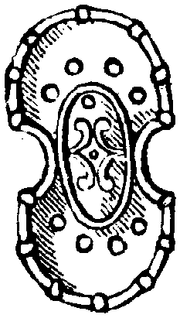
Ancile
Encyclopedia

Ancient Rome
Ancient Rome was a thriving civilization that grew on the Italian Peninsula as early as the 8th century BC. Located along the Mediterranean Sea and centered on the city of Rome, it expanded to one of the largest empires in the ancient world....
, is the legendary buckler
Buckler
A buckler is a small shield, 15 to 45 cm in diameter, gripped in the fist; it was generally used as a companion weapon in hand-to-hand combat during the Medieval and Renaissance, as its size made it poor protection against missile weapons but useful in deflecting the blow of...
shield of the god Mars, said to have fallen from heaven
Heaven
Heaven, the Heavens or Seven Heavens, is a common religious cosmological or metaphysical term for the physical or transcendent place from which heavenly beings originate, are enthroned or inhabit...
, upon Numa Pompilius
Numa Pompilius
Numa Pompilius was the legendary second king of Rome, succeeding Romulus. What tales are descended to us about him come from Valerius Antias, an author from the early part of the 1st century BC known through limited mentions of later authors , Dionysius of Halicarnassus circa 60BC-...
. At the same time, a voice was heard which declared that Rome should be mistress of the world while the shield was preserved. The Ancile was, as it were, the palladium
Palladium (mythology)
In Greek and Roman mythology, a palladium or palladion was an image of great antiquity on which the safety of a city was said to depend. "Palladium" especially signified the wooden statue of Pallas Athena that Odysseus and Diomedes stole from the citadel of Troy and which was later taken to the...
of Rome.
Different authors give different etymologies of this word. Some derive it from the Greek
Greek language
Greek is an independent branch of the Indo-European family of languages. Native to the southern Balkans, it has the longest documented history of any Indo-European language, spanning 34 centuries of written records. Its writing system has been the Greek alphabet for the majority of its history;...
ἀγκύλος, "crooked". Varro
Varro
Varro was a Roman cognomen carried by:*Marcus Terentius Varro, sometimes known as Varro Reatinus, the scholar*Publius Terentius Varro or Varro Atacinus, the poet*Gaius Terentius Varro, the consul defeated at the battle of Cannae...
derives it ab Ancisu, as being cut or arched on the two sides, like the bucklers of the Thracians
Thracians
The ancient Thracians were a group of Indo-European tribes inhabiting areas including Thrace in Southeastern Europe. They spoke the Thracian language – a scarcely attested branch of the Indo-European language family...
, called peltæ. Plutarch
Plutarch
Plutarch then named, on his becoming a Roman citizen, Lucius Mestrius Plutarchus , c. 46 – 120 AD, was a Greek historian, biographer, essayist, and Middle Platonist known primarily for his Parallel Lives and Moralia...
thinks the word may be derived from the Greek ἀγκών, "elbow", this weapon being worn on the elbow. The opinion of Varro, however, is more probable.
Though there was but one Ancile that fell from heaven, there were twelve preserved, called the Ancilia; Numa, by the advice, as it is said, of the nymph
Nymph
A nymph in Greek mythology is a female minor nature deity typically associated with a particular location or landform. Different from gods, nymphs are generally regarded as divine spirits who animate nature, and are usually depicted as beautiful, young nubile maidens who love to dance and sing;...
Egeria
Egeria (mythology)
Egeria was a nymph attributed a legendary role in the early history of Rome as a divine consort and counselor of the Sabine second king of Rome, Numa Pompilius, to whom she imparted laws and rituals pertaining to ancient Roman religion...
, ordered eleven others, perfectly like the first, to be made. This was so that if anyone should attempt to steal it, as Ulysses
Odysseus
Odysseus or Ulysses was a legendary Greek king of Ithaca and the hero of Homer's epic poem the Odyssey. Odysseus also plays a key role in Homer's Iliad and other works in the Epic Cycle....
did the Palladium, they might not be able to distinguish the true Ancile from the false ones.
These Ancilia were preserved in the temple of Mars, and were committed to the care of twelve priests of Salii
Salii
In ancient Roman religion, the Salii were the "leaping priests" of Mars supposed to have been introduced by King Numa Pompilius. They were twelve patrician youths, dressed as archaic warriors: an embroidered tunic, a breastplate, a short red cloak , a sword, and a spiked headdress called an apex...
, instituted for that purpose by Numa . They were carried every year, in the month of March, in procession around Rome, and on the 30th day of that month, were again deposited in their place.

